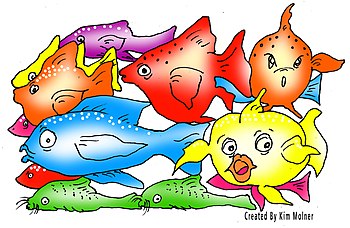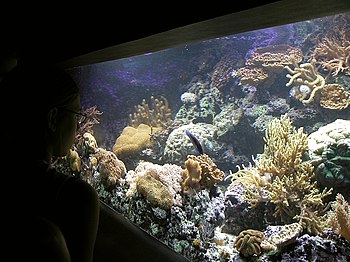 |
| Mid 19th Century glass freshwater aquarium, containing Vallisneria spiralis, goldfish, roach, and minnow. (Photo credit: Wikipedia) |
Fishkeeping was started centuries ago. At that time fishes were bred for food. Also, due to religious reasons, fish was eaten on days when meat wasn’t allowed. The Chinese and Japanese traditions included fish keeping for food purposes. But later the kings began keeping goldfishes and koi, because of their attractive colors. They were kept in ponds and when guests used to arrive, the fishes were shifted indoors in fish bowls. Romans were also known to keep lampreys in pools with saltwater. Ancient Egyptians kept fishes from Oxyrhynchus in temple pools.
Saltwater or marine fish keeping is more difficult and expensive. Usually experienced fish keepers or aquarists are into this hobby. This is certainly not for beginners. But it sure is very attractive with colorful and attractive fishes along with different types of corals. Brackish fish keeping involves both freshwater and saltwater fish keeping because the salinity of the water is in between that of seawater and freshwater.
Fish keepers which are into this hobby also focus on the aquatic plants. Some hardcore aquarists even attempt to grow coral reefs with the help of living rock, worms, and calcareous rocks with algae growth, sponges, and worms. When the corals begin to grow echinoderms, crabs, mollusks, and shrimps are also added to the aquariums, which are also called reef tanks.
The aquarium should have ecology which is similar to the natural habitat of the occupant fishes. This is an extremely difficult task. Also, it is important to maintain the predator-prey relationship balance. Also more than the volume of the water, the surface volume is important. This is because, more the surface volume, more the oxygen levels in the water. Air pumps also are used to increase the dissolved oxygen in the water. This is part of the nutrient cycle, which should be maintained and controlled for the well-fare of the fishes. Larger aquariums are more preferable and they make things easier, for example, the event effects are diluted easily and the systemic shock is absorbed well.
Other factors to be controlled are the nitrogen cycle, dissolved gases, and balanced food supply. The salinity of the water should be checked regularly depending on the aquaria being maintained. The pH level should be checked to test the acidic nature of the water. For the freshwater aquarium, most of the aquarist use tap water, which is a mistake as it contains chlorine. Chloramines should be used in tap water to make it chlorine-free.
Depending on the temperature, the aquarium can be differentiated to have tropical and cold water. For the tropical aquariums, the water should be warm and the temperature should be nearly seventy-seven degrees Fahrenheit. For cold water aquarium, the water temperature should be less than room temperature. For this purpose, a refrigeration device called chiller can be used.
Plants and certain organisms can be introduced in the aquarium which metabolizes the waste, especially nitrogen. But more the number of organisms added to the fish tank, the more difficult it is to maintain. The needs of all the aquatic organisms must be considered. Introducing many types of species in an aquarium is known as biological loading. Two important factors should be considered which include filtration process and oxygen levels. Aquarists interested in fish breeding should be more careful. Firstly, they shouldn’t mix many types of fishes together. They should also develop special conditions called spawning triggers for proper breeding.
Artificial ponds can be also made in the garden. It is very similar to freshwater keeping, except that they are big and out in natural conditions. Tropical fishes are a good choice for such garden ponds. But where the temperatures are cold, goldfishes, orfe, and koi are good options.















